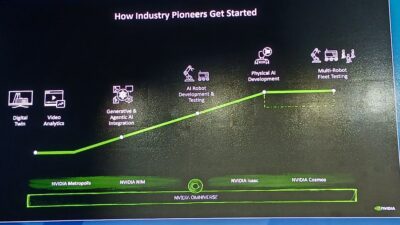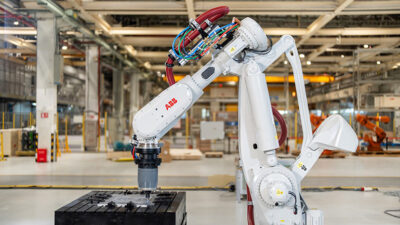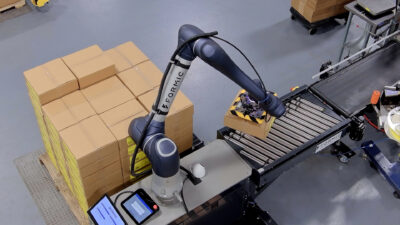Industrie 4.0 is not a distant vision for the factory of the future. Already networks of robots are connecting to the cloud and contributing massive amounts of insightful data to simplify asset management and maintenance, maximize equipment and process efficiency, and improve product quality.
Industrie 4.0 may seem more conceptual than real. For many manufacturers, the Industrial Internet of Things (IIoT), cyber-physical systems, cloud robotics, fog computing, and big data, can be intimidating. Visions of a smart factory can make us feel pretty dumb.
The smart factory connects the digital world of information technology with the physical world of operational technology, what many call information technology/operations technology (IT/OT) convergence. But Industrie 4.0 is not a distant vision for the factory of the future. It is here and it is now. Networks of robots are connecting to the cloud and contributing massive amounts of insightful data. Today, manufacturers are using these information pipelines to simplify asset management and maintenance, maximize equipment and process efficiency, and improve product quality.
Stop downtime before it occurs
General Motors (GM) is putting IoT and the building blocks of Industrie 4.0 to work-today. The automaker’s robot supplier and strategic partner, Fanuc America Corporation, is helping GM build a strong foundation for smart manufacturing. GM, Fanuc, and Cisco together developed the zero down time (ZDT) solution, which uses a cloud-based software platform to analyze data collected from robots across GM’s factories in order to detect potential problems that could lead to production downtime.
In automobile manufacturing where a new car body comes down the assembly line every 60 or 90 seconds, downtime can cost original equipment manufacturers (OEMs) over $20,000 a minute. A single downtime incident easily could rack up millions in losses. When lines screech to a halt, those backups can impact the entire supply chain, further compounding the losses. The delays also trickle down to customers, automotive dealers, fleet users, and the car-buying public.
"We’ve had initiatives ongoing for some time now trying to better predict and maintain the health of our manufacturing equipment," said Marty Linn, manager of Advanced Automation Technologies and principal engineer of robotics at GM in Detroit, Mich. "We got together with Fanuc and talked about what we could do to avoid issues while we’re doing productive manufacturing. This wasn’t some great vision for Industrie 4.0. It was about what we can do to eliminate downtime in our plants from unpredicted maintenance."
A ZDT pilot program was launched at GM in 2014. The strategic partnership between GM and FANUC was a key enabler for the successful launch. The history between the two companies dates back to the early 1980s, when GM entered into a joint venture with the Japanese robot manufacturer to form GMFanuc Robotics Corporation to develop and market robots in the U.S. The venture would later be divested, but the strong relationship continued. "We’re integrating robots as we speak. Every day we have robots and systems from our integrators that get shipped to the plants as we’re introducing new products and new programs," Linn said.
Return on investment (ROI)
ZDT continues to make a difference on the plant floor for the company. Linn said GM has been able to avoid over 100 significant unscheduled downtimes since the program’s inception.
"That avoids on the order of six to eight hours of unscheduled downtime, depending on what was going to fail. You can do the math. It’s a lot. It’s a big deal to us for any of our facilities, but especially in our high-volume truck and SUV plants, where each downtime event is significant."
With thousands of robots connected and communicating with the cloud, it wasn’t long before GM began realizing their return on investment (ROI).
"This is not ‘Jetsons’ technology," Linn said. "This is using Big Data, the internet of things, new algorithms, computer capacity, all those things that have evolved over the past years, and using them in the most efficient way. Preventing downtime, and anticipating or even forgoing maintenance until it’s needed, is huge."
Maintenance only when needed
GM started slowly, connecting a couple thousand robots over the first year or two. By 2017, though, over 8,500 Fanuc robots were connected.
"We started out slow with the deployment," Linn said. "When we saw a problem, we went in and replaced parts. Then we studied those parts. Sure enough, we’ve been able to validate and verify that those parts were going to fail. They were going to cause us downtime. It was at that point when we were able to reduce unscheduled maintenance events that everybody got really excited and started saying, this is great, what else can we do with it?"
GM is also using ZDT to schedule maintenance only as needed, rather than beholden to routine maintenance schedules.
"For example, a robot might be designed to have routine scheduled maintenance at 1,000 hours. So we would plan to maintain it at that time," says Linn. "But it might actually last 1,250 hours before it needs maintenance. So we’re working on getting away from fixed maintenance schedules to instead schedule as needed. This is one of the major ways you can find significant savings going forward."
Machine learning
ZDT doesn’t only apply to robots. It’s also applicable to process equipment. Processes that are directly controlled by the robot, such as welding, painting, and some dispensing applications. Linn cited GM’s automotive paint shop as an example.
"Looking at air pressures, looking at downdraft pressures, the speeds of the actuators that are dispensing the paints, looking at a lot of the paint processes and the parameters that go into that, we’re able to monitor the health of the equipment and therefore the quality of the job," Linn said.
Finish quality is crucial in the automotive paint shop. All of Fanuc’s paint robots are ZDT-ready, which means they can monitor a variety of functions including paint canisters, spray applicators, regulators, and drive health.
"If you count the total number of moving parts that relate to automotive painting, there are over 200 moving parts per robot," Tsai said. "A significant number of those moving parts are related to the process-specific devices controlling the gun, regulator, and pressure. If any one of those devices have any kind of premature failure, it can cause a quality issue and/or production downtime."
Right now, GM is using ZDT more as a predictive maintenance tool as opposed to an in-process adaptive tool. But as the technology evolves, and more data is collected and analyzed, and the algorithms get more sophisticated, you can see how with machine learning it could become more of an adaptive tool for real-time process improvement.
"In the case of the paint shop, by recognizing and understanding that there are very subtle process changes going on and correcting for those, we’re able to improve our processes," Linn said. "We want to expand this strategy of having the equipment be smart, able to diagnose itself, and notify us of changes to its operational performance, so that we can go in during the opportunities that suit us to make adjustments or repairs as needed."
Automotive and beyond
Fanuc’s analytics solution is monitoring over 10,000 cloud-connected robots at customers’ facilities around the world, and growing every day. While it is currently used in the automotive industry, Fanuc plans to release software and hardware support for general industry, non-automotive customers in late 2017.
"Our solution needs to be scalable for small general industry manufacturers with two to three robots," Tsai said. "The way you install the software and set up the hardware needs to be plug and play for the smaller manufacturer, because they don’t have the IT department to support it."
Eventually, Fanuc and Cisco intend to use this data communication highway developed for ZDT to connect other equipment beyond robots. ZDT is part of the Fanuc Intelligent Edge Link and Drive (FIELD) system, which provides an open software platform that allows for advanced analytics and deep learning capabilities for CNCs, robots, peripheral devices, and sensors used in automation systems. FIELD is based on edge computing technology where a large amount of data is processed within the manufacturing site at the edge of the network, thereby minimizing the volume and cost of sharing data.
"With the ZDT Cloud solution the data is flowed from the devices on the production floor all the way to the cloud, where you will have latency or delays," Tsai said. "The benefit of receiving the data on the floor using the FIELD platform is then you can respond to the event in real time, and that’s what the FIELD does. It’s a piece of open platform software that can be loaded into computing hardware, which then allows you to access data from the robot, the programmable logic controller (PLC), or the machine tool device, and apply analytics in real time. It can even change your production based on how you behave. That’s where real-time machine learning can provide good value.
"Industrie 4.0 is not just a dream. It’s real," Tsai said. "It’s an exciting time for automation."
Exciting indeed, as more robot manufacturers introduce their own IIoT solutions for embracing the level of connectivity heralded by Industrie 4.0.
Robot data at your fingertips
Kuka Connect is a cloud-based software platform that allows customers to easily access and analyze data from their Kuka robots on any device, anywhere at any time. The solution provides three main functions: asset information management, condition monitoring, and maintenance alerts.
"If you are a big OEM customer, you may have thousands of robots in one facility," said Andy Chang, director of product marketing, Americas, at Kuka. "The way they manage asset information management today is by using giant Excel spreadsheets that are manually maintained. The information on the spreadsheet may or may not be accurate and they may not actually know what type of robots they have."
Chang said that not having the right asset information could impact how well the robots are maintained over their lifetime.
"You can easily look up all the thousands of robots around the plant and navigate through them individually to see when they were commissioned, check serial numbers, and what software is currently installed without having to physically walk up to the machines."
For condition monitoring, Kuka Connect is designed to provide specific robot key performance indicators (KPIs) to help technicians and the maintenance crew gauge how well the robot is performing. Chang describes an example.
"We provide temperature charts for all the different axes on a robot," Chang said. "So if the production person or maintenance person starts observing that the trend of the temperature graph for a particular axis has been going up over the last week, that probably means a couple of things. One, the gearbox is probably overheating for whatever reason, or two, maybe the payload has to change. The object that the robot is picking up is maybe not what the machine was designed for."
Kuka Connect is designed to work on desktops as well as mobile devices, smartphones, tablets, or anything that supports a web browser. Intuitive dashboards help users visualize data according to specific criteria. Whether you’re trying to optimize your maintenance schedule or manage spare parts inventory, all the data is at your fingertips, so you can anticipate potential downtime and take steps to fix issues before downtime occurs.
"Today, there are two ways that Kuka Connect provides information," Chang said. "One is very literal. When there is a controller error message, we provide the real-time notification to the user with the error code and the error description, so it’s very dynamic. The second part is more passive. We present the data to the end user and then they will need to interpolate what that means for their robot, their line, their factory."
The software platform not only interfaces with the robots, it will also monitor the automation equipment controlled by the robot controller, such as a welding gun or gluing gun, or even an additional axis if the robot is on a rail.
"Any information that is controlled or aided by the robot control will be part of the platform," Chang said. "That’s something we are currently working on, is the ability to actually visualize the robot data in conjunction with the process-specific data, so the end user can understand not only the health of the mechanics of the machine, but also the key performance of the process itself."
Born and bred in Austin
Kuka Connect was born and developed in Texas and is the product of a German robot manufacturer recently acquired by Chinese appliance maker Midea. This division in Austin, Tex., was established in 2015 and is part of Kuka AG.
Austin might seem like an atypical location, but Chang said the city has developed into a major technology hub.
"We’ve definitely seen momentum over the last 10 years. And similar to California, we have a really good education system with The University of Texas at Austin just down the street, and then Texas A&M and Rice University," Chang said. "Compared to other places like Silicon Valley and Boston, the cost is very attractive from a business standpoint. There is definitely a tremendous robotics community that’s been brewing."
Chang said Kuka Connect was envisioned, developed, and released all in the Austin office. They recently exhibited at SXSW 2017, where their bottle flipping robot made an impact on the crowd.
Workforce development for Industrie 4.0
To truly realize the vision of Industrie 4.0 and the smart factory, we will need vast talent pools across multiple geographic regions and industries to bridge the growing skills gap. One company, Festo, is helping to build that talent pool and nurture the skills required for the factory of the future.
Festo is a global manufacturer of pneumatic and electromechanical systems, controls, and components for process control and factory automation solutions. The German automation supplier has already put Industrie 4.0 into practice at their own factory, the Scharnhausen Technology Plant, where they make valves, valve terminals, and electronics. Their daughter company, Festo Didactic, is a worldwide leader in industrial education for technical training institutions and manufacturing companies.
At the Automate conference in April, Ted Rozier, engineering development manager for Festo Didactic Inc. in Eatontown, N.J., gave a presentation about how more than 300,000 U.S. manufacturing jobs go unfilled for lack of qualified candidates. That number is expected to grow.
"It’s important to teach students to be familiar with the complete portfolio of automation hardware and the software," Rozier said. "They need to understand the integration process of robots and PLCs, as well as be familiar with how IoT can enhance the complete process. This is common practice in Europe and we are looking to raise the visibility of this type of training in North America."
Rozier stressed the importance of multidisciplinary learning, especially focusing on mechatronics.
"The Internet of Things has to thrive in order to assist in bringing life to Industrie 4.0. To do that, you need a strong IT background and strong mechatronics background. We have the opportunity to breed individuals that can not only understand, but influence automation manufacturing processes from the top floor to the shop floor, from the IT level down to the sensors that assist in helping robotics make decisions. That’s an important skill going forward."
The learning factory
Festo Didactic provides "learning factory modules" for hands-on industrial training in mechatronics, control technology, and automation technology. The system starts with a single Project Workstation I4.0 for teaching the fundamentals of control technology. Several modules then can be added to create a complete learning cyber-physical (CP) factory, which can include a realistic industrial pallet circulating system and an autonomous mobile robot to connect different workstations.
The system is modular so individual workstations can be added, removed, and moved around as learning requirements change. Training topics include: PLC project engineering, working with human machine interfaces (HMIs) and radio frequency ID (RFID) sensors, commissioning the web server and TCP/IP and OPC-UA interfaces, energy monitoring and management, working with intelligent process data modules, enterprise resource planning (ERP) systems, manufacturing execution systems (MES), and rapid prototyping.
Community colleges with manufacturing and STEM tracks are using Festo’s CP factory modules to prepare their students for jobs immediately upon graduation. York Technical College in Rock Hill, South Carolina, has an entire room devoted to the CP Factory, with about six modules. Companies like Mercedes-Benz in Vance, Alabama, are using Festo learning equipment to enhance their workers’ knowledge.
We must prepare our workforce for the new ways in which humans, machines, and data will interact in a hyperconnected world. There are steps you can take now to prepare for Industrie 4.0 and the smart factory.
Tanya M. Anandan is contributing editor for the Robotic Industries Association (RIA) and Robotics Online. RIA is a not-for-profit trade association dedicated to improving the regional, national, and global competitiveness of the North American manufacturing and service sectors through robotics and related automation. This article originally appeared on the RIA website. The RIA is a part of the Association for Advancing Automation (A3), a CFE Media content partner. Edited by Chris Vavra, production editor, Control Engineering, CFE Media, [email protected].
MORE ADVICE
Key Concepts
- Networks of robots are connecting to the cloud and contributing mass amounts of insightful data.
- Automotive companies are using robots and Industrie 4.0 to reduce downtime and improve efficiency on the plant floor.
- Robots connected to Industrie 4.0 are being used in educational settings to give students a better idea of how robots work in a modern setting.
Consider this
What future developments in robotics and Industrie 4.0 will improve efficiency on the plant floor?
ONLINE extra
See additional stories from the RIA linked below.



